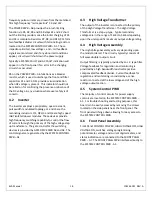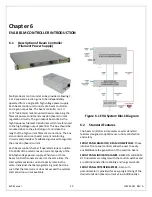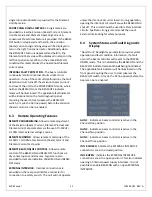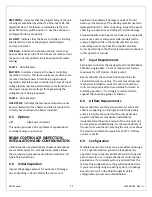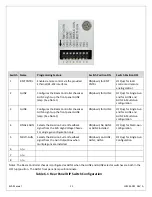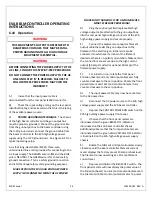
EVA
Manual
9
118144
‐
001
REV.
A
REMOTE
MONITORS
:
Test
points
are
made
available
on
the
rear
panel
interface
connecter
for
monitoring
the
current
and
voltage;
pin
5
and
pin
6
respectively.
The
test
points
are
always
positive,
scaling
is
such
that
0
‐
10Vdc
corresponds
to
0
‐
100%
rated
output.
Test
points
have
an
output
impedance
of
1k
ohms,
±1%.
See
Figure
3.3
for
test
point
designation.
LOCAL/REMOTE
CONTROL
POWER/HV
ON/HV
OFF:
Allows
for
command
of
CONTROL
POWER,
HIGH
VOLTAGE
ON
and
HIGH
VOLTAGE
OFF
by
either
the
front
panel
controls
or
external
signals
via
the
rear
panel
external
interface
connecter.
LOCAL
CONTROL
‐
For
local
front
panel
switch
command
of
the
Control
Power
functionality
a
maintained
connection
between
pin
12
and
pin
13
is
required.
Once
connected
as
outlined
above,
the
front
panel
CONTROL
POWER
switch
will
alternate
latch
on/latch
off
with
each
successive
pressing
of
the
switch.
For
local
front
panel
command
of
the
HIGH
VOLTAGE
OFF
functionality
a
maintained
connection
between
pin
14
and
pin
15
is
required.
REMOTE
CONTROL
–
Remote
control
of
CONTROL
POWER,
HIGH
VOLTAGE
ON
and
HIGH
VOLTAGE
OFF
can
be
accomplished
via
the
rear
panel
interface.
The
CONTROL
POWER
is
an
on
‐
off
toggle
contact
between
pins
12
and
13.
With
the
front
panel
CONTROL
POWER
switch
latched
in
the
“ON”
position,
opening
and
closing
the
connection
between
pins
12
and
pins
13
will
allow
remote
command
of
the
CONTROL
POWER
functionality.
HIGH
VOLTAGE
OFF
and
HIGH
VOLTAGE
ON
are
controlled
by
momentary
normally
closed;
normally
open
contacts,
respectively
between
pins
14
and
15,
and
pins
15
and
16.
See
Figure
3.4
for
recommended
interface.
EXTERNAL
INHIBIT:
The
External
inhibit
allows
the
user
to
inhibit
the
power
supply
output
without
putting
the
power
supply
into
the
HIGH
VOLTAGE
OFF
mode.
This
circuit
can
be
used
to
generate
fast
slewing
output
waveforms.
The
maximum
inhibit
rate
should
not
exceed
5Hz.
Consult
factory
for
higher
repetition
rates
or
high
pulse
load
applications.
See
Figure
3.5
for
the
recommended
interface
circuit.
WARNING
IT
IS
EXTREMELY
DANGEROUS
TO
USE
THE
EXTERNAL
INHIBIT
TO
STOP
HIGH
VOLTAGE
GENERATION
FOR
THE
PURPOSE
OF
SERVICING
OR
APPROACHING
ANY
AREA
OF
THE
LOAD
CONSIDERED
UNSAFE
DURING
HIGH
VOLTAGE
OPERATION
EXTERNAL
INTERLOCK
:
The
External
Interlock
connections
are
provided
on
the
rear
panel
interface
connecter,
pin
3
and
pin
4,
intended
for
use
in
the
connection
to
a
customer
provided
and
implemented
external
safety
switch.
The
unit
will
not
enable
into
HIGH
VOLTAGE
ON
unless
the
interlock
circuit
is
closed.
If
the
interlock
is
not
being
used
(use
is
highly
recommended),
a
jumper
must
be
installed.
During
high
voltage
operation,
opening
the
External
Interlock
will
cause
the
unit
to
revert
to
the
HIGH
VOLTAGE
OFF
mode.
Subsequent
closing
of
the
interlock
circuit
will
NOT
return
the
unit
to
HIGH
VOLTAGE
ON
mode;
this
must
be
accomplished
by
depressing
the
HIGH
VOLTAGE
ON
switch.
See
Figure
3.6
for
the
recommended
interface
circuit.
ARC
DETECT/ARC
QUENCH/ARC
COUNT
:
The
ARC
Intervention
Circuitry
senses
dynamic
arcing
or
discharge
conditions
present
at
the
output
load
with
a
wide
bandwidth
current
transformer
coupled
to
the
return
side
of
the
high
voltage
multiplier.
The
instant
an
arc
is
detected
the
generation
of
high
voltage
is
electronically
inhibited
for
1
millisecond;
this
is
called
the
ARC
Quench
time
period.
After
the
1
millisecond
period,
the
discharged
high
voltage
output
(level
dependent
upon
arc
impedance,
arc
duration,
etc.)
is
ramped
back
up
to
the
previous
set
level.
This
Arc
ReRamp
ramp
time
is
2
milliseconds.
The
ARC
indicator
on
the
front
panel
will
illuminate
for
approximately
1
second
after
each
arc
has
occurred.
The
HV
INHIBIT
indicator
will
also
illuminate
indicating
that
the
output
is
being
inhibited
(ARC
Quench).
























